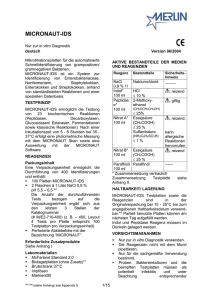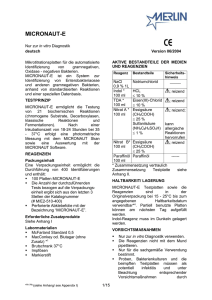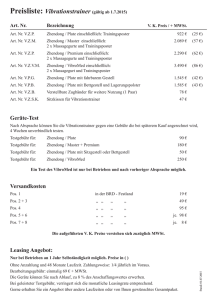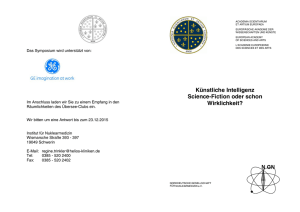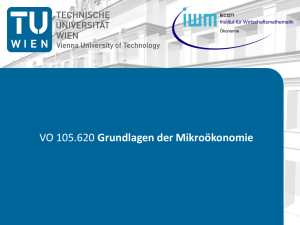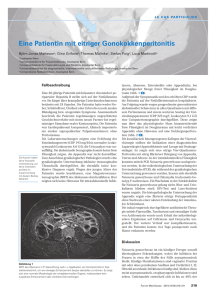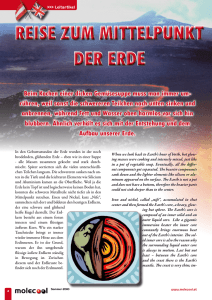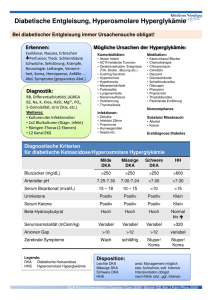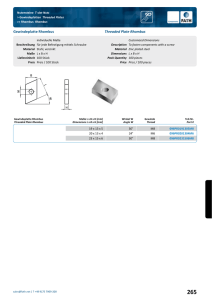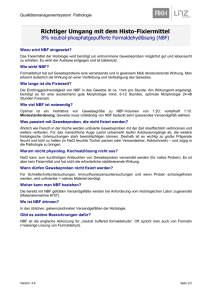micronaut-rpo - bag health care
Werbung
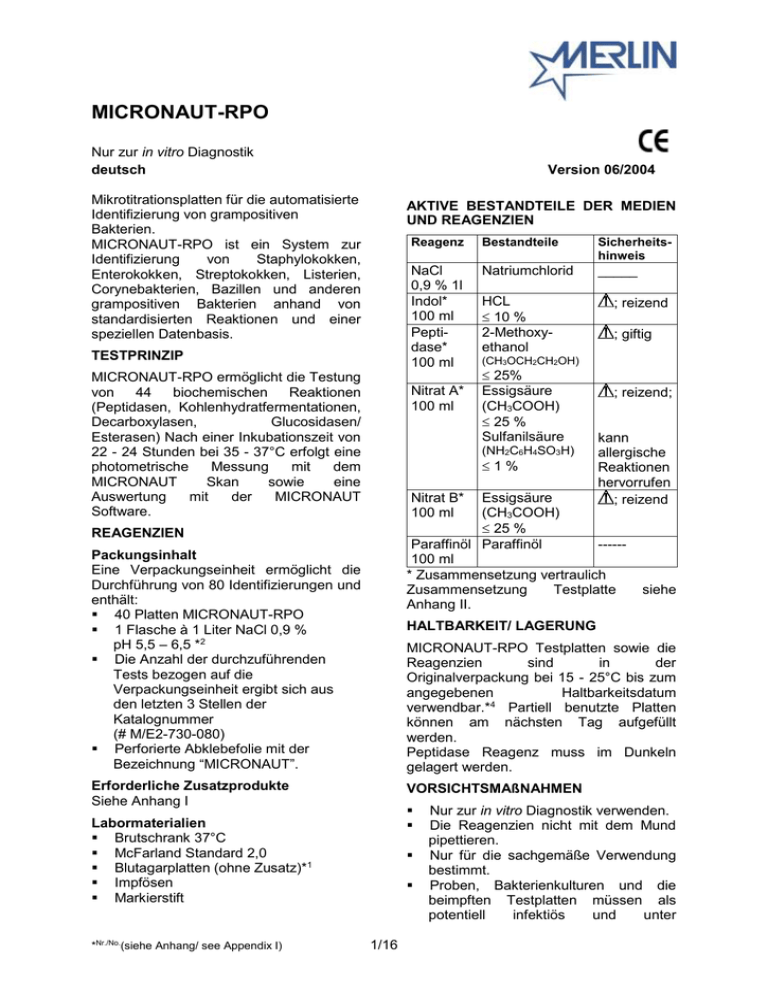
MICRONAUT-RPO Nur zur in vitro Diagnostik deutsch Version 06/2004 Mikrotitrationsplatten für die automatisierte Identifizierung von grampositiven Bakterien. MICRONAUT-RPO ist ein System zur Identifizierung von Staphylokokken, Enterokokken, Streptokokken, Listerien, Corynebakterien, Bazillen und anderen grampositiven Bakterien anhand von standardisierten Reaktionen und einer speziellen Datenbasis. AKTIVE BESTANDTEILE DER MEDIEN UND REAGENZIEN TESTPRINZIP MICRONAUT-RPO ermöglicht die Testung von 44 biochemischen Reaktionen (Peptidasen, Kohlenhydratfermentationen, Decarboxylasen, Glucosidasen/ Esterasen) Nach einer Inkubationszeit von 22 - 24 Stunden bei 35 - 37°C erfolgt eine photometrische Messung mit dem MICRONAUT Skan sowie eine Auswertung mit der MICRONAUT Software. Reagenz Bestandteile Sicherheitshinweis NaCl 0,9 % 1l Indol* 100 ml Peptidase* 100 ml Natriumchlorid _____ Nitrat A* 100 ml HCL 10 % 2-Methoxyethanol ; giftig (CH3OCH2CH2OH) 25% Essigsäure (CH3COOH) 25 % Sulfanilsäure (NH2C6H4SO3H) 1% Nitrat B* 100 ml ; reizend; kann allergische Reaktionen hervorrufen ; reizend Essigsäure (CH3COOH) 25 % Paraffinöl Paraffinöl -----100 ml * Zusammensetzung vertraulich Zusammensetzung Testplatte Anhang II. REAGENZIEN Packungsinhalt Eine Verpackungseinheit ermöglicht die Durchführung von 80 Identifizierungen und enthält: 40 Platten MICRONAUT-RPO 1 Flasche à 1 Liter NaCl 0,9 % pH 5,5 – 6,5 *2 Die Anzahl der durchzuführenden Tests bezogen auf die Verpackungseinheit ergibt sich aus den letzten 3 Stellen der Katalognummer (# M/E2-730-080) Perforierte Abklebefolie mit der Bezeichnung “MICRONAUT”. siehe HALTBARKEIT/ LAGERUNG MICRONAUT-RPO Testplatten sowie die Reagenzien sind in der Originalverpackung bei 15 - 25°C bis zum angegebenen Haltbarkeitsdatum verwendbar.*4 Partiell benutzte Platten können am nächsten Tag aufgefüllt werden. Peptidase Reagenz muss im Dunkeln gelagert werden. Erforderliche Zusatzprodukte Siehe Anhang I VORSICHTSMAßNAHMEN Labormaterialien Brutschrank 37°C McFarland Standard 2,0 Blutagarplatten (ohne Zusatz)*1 Impfösen Markierstift *Nr./No.(siehe Anhang/ see Appendix I) ; reizend 1/16 Nur zur in vitro Diagnostik verwenden. Die Reagenzien nicht mit dem Mund pipettieren. Nur für die sachgemäße Verwendung bestimmt. Proben, Bakterienkulturen und die beimpften Testplatten müssen als potentiell infektiös und unter Beachtung entsprechender Vorsichtsmaßnahmen durch entsprechend qualifiziertes Fachpersonal sachgemäß behandelt werden. Während der gesamten Testdurchführung muss aseptisch gearbeitet werden. Informationen finden Sie in „BioSafety in Microbiological and Biomedical Laboratories, HHS Publikation No. (CDC) 99-8395, 4th Edition (April 1999)“, oder in den entsprechenden nationalen gesetzlichen Vorgaben. Nach Ablesung und Auswertung der Tests müssen alle Proben, beimpfte und kontaminierte Produkte (Pipettenspitzen, Reservoirs und Testplatten) autoklaviert, verbrannt oder mit einer bakteriziden Desinfektionslösung behandelt werden, bevor sie entsorgt werden. Die strikte Einhaltung der Arbeitsanleitung ist unbedingt erforderlich, jede Abweichung kann die Qualität der Ergebnisse beeinflussen. Die Interpretation der Testergebnisse sollte durch geschultes, erfahrenes Personal auf dem Gebiet der Mikrobiologie erfolgen. Der klinische Hintergrund, Probenherkunft, Kolonienund mikroskopische Morphologie, Serologie und das Antibiogramm müssen bei der Interpretation der Ergebnisse berücksichtigt werden. A12 E12 B12 F12 C12 G12 D12 H12 Versiegelung und Inkubation Nach dem Beimpfen die Testplatte mit der „MICRONAUT“ Folie verschließen (perforiert).*5 Testplatte 22 - 24 Stunden bei 35 37°C inkubieren.*6 Ablesung Abklebefolie entfernen. Testplatte von unten abwischen. Zugabe von 2 Tropfen (50 µl) Peptidase Reagenz in folgende Vertiefungen: TESTDURCHFÜHRUNG Probenvorbereitung Gram Präparat: Grampositive Bakterien erscheinen blau, gramnegative Bakterien rot. Ein Röhrchen mit 6 ml NaCl 0,9 % pH 5,5 bis 6,5*2 bereitstellen. Mehrere einzeln liegende Kolonien einer 18 - 24 Stunden alten Reinkultur vom Blutagar (ohne Zusatz) abnehmen*1. A1,2,3,4 E1,2,3,4 B1,2,3,4 F1,2,3,4 C1,2,3,4 G1,2,3,4 D1,2,3,4 H1,2,3,4 Warten Sie nach Zugabe der Reagenzien mindestens 5 Minuten, aber nicht länger als 30 Minuten bis zur Messung der Testplatte. Ablesung der Testplatte mit dem MICRONAUT Skan. Auswertung Achtung: Für die automatisierte Auswertung muss in der Software ein Verdacht in Form eines Codes eingegeben werden. Dies kann unter „Isolate erfassen“ oder unter „Auswertungen bearbeiten“ geschehen. Herstellung des Inokulums Die Kolonien in 6 ml NaCl 0,9 % gut homogenisieren, bis die Trübung einem McFarland von 2,0 entspricht.*3,8 STR für Katalase – negative Kokken STA für Katalase – positive Kokken, und Stomatokokken COR für Corynebakterien, Listerien und verwandte Mikroorganismen Beimpfung MICRONAUT-RPO Testplatte vor der Beimpfung aus der Einzelverpackung entnehmen und das Trockenmittel verwerfen.*4 *Nr./No.(siehe Anhang/ see Appendix I) Die Testplatte beschriften. Die vorbereitete Suspension gemäß der Plattenbelegung in ein 2-KanalReservoir geben.*5 Je Identifizierung werden vier Reihen mit je 100 µl pro Vertiefung beimpft. Die Beimpfung der Mikrotitrationsplatte erfolgt manuell mit der MICRONAUT Pipette oder automatisiert mit dem MICRONAUT Sprint. Zugabe von je 2 Tropfen (50 µl) Paraffinöl in folgende Vertiefungen: 2/16 BAC für Bazillen und andere grampositive Bakterien. Die Messwerte werden anhand einer photometrischen Messung bei verschiedenen Wellenlängen ermittelt. Diese werden mit Hilfe der MICRONAUT Software ausgewertet und interpretiert (siehe Arbeitsanleitung MICRONAUT Software). Die Auswertung erfolgt über Berechnungsalgorhythmen, die zu einem positiven oder negativen Ergebnis der einzelnen Reaktionen führt. Dabei erleichtern Negativ-Kontrollen eine eindeutige Beurteilung der biochemischen Reaktionen. Das Testergebnis kann am Bildschirm oder auf dem Befundausdruck mit Angaben der Wahrscheinlichkeiten angeschaut werden. Die Wahrscheinlichkeitsberechnung erfolgt über die in der MICRONAUT Datenbank enthaltenen Reaktionsmuster. Unter den Testergebnissen können Vermerke erscheinen, die Hinweise auf zu geringes Wachstum geben oder erforderliche Zusatztests anzeigen. ZUSATZREAKTIONEN Nitrat Reduktion Zugabe von je einem Tropfen (25 µl) Nitrat A und Nitrat B Reagenz in die ONC-Reaktion: A8 E8 Eine positive Reaktion wird durch eine Rotfärbung angezeigt. -Hämolyse Bereiten Sie die Blutagarplatte entsprechend der Herstellervorschrift oder entsprechend einem mikrobiologischen Standardprotokoll vor. Beimpfen Sie den zu testenden Stamm auf die Blutagarplatte. Inkubation der Platte 24 Stunden bei 35 - 37°C unter 5 % CO2 Atmosphäre. Eine -Hämolyse (Aufhellung) um die Kolonie ist als positiv zu beurteilen. Keine Aufhellung oder nur Vergrünung der Kolonie ist als negativ zu bewerten. Katalase Einen Tropfen 3 %-ige H2O2 –Lösung auf einen Objektträger geben und eine Kolonie darin verreiben. *Nr./No.(siehe Anhang/ see Appendix I) 3/16 Rasche Entwicklung von Gasbläschen wird als positiv bewertet. Keine Gasbläschen bedeutet ein negatives Ergebnis. HIP Hippuratsäurehydrolyse Bereiten Sie eine Na-Hippurat Lösung entsprechend der Herstellervorschrift oder entsprechend einem Mikrobiologischem Standardprotokoll vor. Beimpfen Sie die Na-Hippurat Lösung mit dem Bakterium bis die Lösung eine Trübung aufweist. 2 Stunden inkubieren bei 35 - 37 °C. Zugabe von 0,2 ml NinhydrinReagenz, Röhrchen nicht schütteln und 15 Minuten stehen lassen. Eine tiefe Purpurfärbung ist als positiv zu bewerten. Keine oder nur geringe Färbung zeigt ein negatives Ergebnis an. Wahrscheinlichkeit, welche die Zuverlässigkeit der Identifizierung bewerten. Zur Bestimmung der absoluten Wahrscheinlichkeit werden die Wahrscheinlichkeiten, mit der die einzelnen Tests positiv ausfallen multipliziert. Das Ergebnis wird als Kehrwert dargestellt, wobei gilt: je kleiner der Wert desto größer die Übereinstimmung zwischen dem erzielten Ergebnis und dem entsprechenden Datensatz in der Datenbank. Zur Berechnung der relativen Wahrscheinlichkeit betrachtet man die Summe der absoluten Wahrscheinlichkeiten aller Keime in der Datenbank. Dann bezieht man die einzelnen absoluten Wahrscheinlichkeiten auf diese Summe. Besteht zwischen dem erzielten Ergebnis und einem Datensatz eine hohe Übereinstimmung und enthält die Datenbank keinen zweiten Datensatz mit ähnlich hoher Übereinstimmung so nähert sich die relative Wahrscheinlichkeit einem 100 %-Wert. Enthält eine Datenbank zwei Datensätze, die eine ähnliche Übereinstimmung mit dem erzielten Ergebnis aufweisen, verringert sich die relative Wahrscheinlichkeit. QUALITÄTSKONTROLLE unterliegen in verschiedenen Stadien der Produktion systematisch durchgeführten Qualitätskontrollen. Die bakteriologische Qualitätskontrolle kann mit den Stämmen in Anhang III durchgeführt werden. Bitte beachten Sie bei der Auswertung der Qualitätskontrollstämme, dass das Identifizierungsergebnis für die Funktionskontrolle der Platte ausschlaggebend ist. Die angegebenen Bioprofile geben einen Hinweis auf das zu erwartende Ergebnis der einzelnen Reaktionen. Abweichungen in einzelnen Reaktionen beeinträchtigen nicht die Funktionstüchtigkeit der Platte sondern beruhen auf statistischen Varianzen. QUALITÄTS- UND LEISTUNGSDATEN Die Daten basieren auf einer großen Sammlung von klinischen Isolaten und Stämmen, die von Referenzlaboratorien zur Verfügung gestellt wurden. Die Identifizierungen wurden durch konventionelle biochemische und molekularbiologische Tests bestätigt. Die Testauswahl und Anzahl ist so gewählt, dass innerhalb der definierten Population mit einer möglichst kleinen Anzahl von Tests die beste Differenzierung der Spezies dieser Population möglich ist. Bei der Untersuchung einer unbekannten Probe wird für jeden im System implementierten Test entweder ein positives oder ein negatives Ergebnis erzielt. Für dieses Bioprofil werden durch Vergleich mit der Datenbank zwei Wahrscheinlichkeiten berechnet, die absolute und die relative *Nr./No.(siehe Anhang/ see Appendix I) 4/16 LIMITIERUNG Das MICRONAUT-RPO System ist nur zur Identifizierung der in der Datenbasis enthaltenen Spezies (siehe Anhang V) bestimmt. Andere Mikroorganismen können weder identifiziert noch ausgeschlossen werden. GEWÄHRLEISTUNG Die Qualitätsdaten des MICRONAUT-RPO Identifizierungssystems wurden mit Hilfe der vorliegenden Arbeitsanleitung ermittelt. Abweichungen oder Änderungen in der Testdurchführung können die Qualität der Ergebnisse beeinträchtigen. Jegliche Entschädigungsansprüche sind in diesem Falle ausgeschlossen. *Nr./No.(siehe Anhang/ see Appendix I) 5/16 MICRONAUT-RPO Only for in vitro diagnostic english Release 06/2004 Micro-titration plates for automated identification of gram-positive bacteria. MICRONAUT-RPO is a system to identify Staphylococci, Enterococci, Streptococci, Listeria, Corynebacteria, Bacillus and other gram-positive bacteria with standardized reactions and a specific data base. ACTIVE COMPONENTS OF THE MEDIA AND REAGENTS TEST PRINCIPLE MICRONAUT-RPO allows the testing of 44 biochemical reactions (peptidases, glcosidases/ esterases, decarboxylases, and fermentations). After incubation of 22 -24 hours at 35 - 37°C a photometrical reading is carried out by means of the MICRONAUT Skan as well as an evaluation by the MICRONAUT Software. Reagent Components NaCl 0.9 % 1L Indole* 100 ml Peptidas e* 100 ml sodium chloride _____ ; irritating ; toxically (CH3OCH2CH2OH) 25% Nitrate A* acetic acid ; irritating; 100 ml (CH3COOH) 25 % sulphanilic acid may cause (NH2C6H4SO3H) allergic reac1% tions Nitrate B* acetic acid ; irritating 100 ml (CH3COOH) 25 % Paraffin paraffin oil -----oil 100 ml * Compound confidential For the compound of the test plate see appendix II. REAGENTS Contents 80 identifications can be performed with one packaging unit. The kit contains: 40 plates MICRONAUT-RPO 1 bottle of 1 liter NaCl 0,9 % (pH 5,5 – 6,5 at 37°C) *2 The last three digits of the catalogue number indicate the number of tests to be performed per packaging unit (# M/E2-730-080) Perforated plate sealers “MICRONAUT”. STABILITY/ STORAGE MICRONAUT-RPO test plates as well as the reagents have to be stored in the original packaging at 15 - 25°C and can be used up to the indicated expiration date*4. Partially used plates can be filled up the next day. Peptidase reagent must be stored in a dark place. Required additional products See appendix I Laboratory materials McFarland standard 2.0 blood agar (without additives)*1 Incubator 37°C Inoculation loops Marking pen PRECAUTIONARY MEASURES *Nr./No.(siehe Anhang/ see Appendix I) HCL 10 % 2-Methoxyethanol Security advice 6/16 Only to be used for in vitro diagnostic. Do not pipette the reagents by mouth. Only for proper use. Samples, bacteria cultures and the inoculated test plates have to be considered as potentially infectious and must be treated properly and with respect to the corresponding precautionary measures by qualified specialist staff. It is important to work aseptically during the whole test procedure. For information please refer to “BioSafety in Microbiological and Biomedical Laboratories, HHS Publication No. (CDC) 998395, 4th Edition (April 1999)“, or to the corresponding national legal requirements. Upon reading and evaluation of the tests, all samples, inoculated and contaminated products (pipette tips, 4channel reservoirs and test plates) must be autoclaved, burnt or disinfected in a bactericidal disinfectant solution before disposal. It is important to follow the instructions carefully, each deviation may influence the quality of the results. The test results should be interpreted by qualified staff with experience in microbiology. The clinical background, origin of the samples, colony and microscopic morphology, serology and the antibiogram must be taken into consideration when interpreting the results. Add two drops (50 µl) of paraffin oil to each of the following wells: A 12 B 12 C 12 D 12 E 12 F 12 G 12 H 12 Sealing and incubation plate with the „MICRONAUT“ plate sealer (perforated)*5. Place in an incubator at 35-37°C for 22–24 hours*6. Reading Remove the plate sealer. Wipe off the bottom of the plate. Add two drops (50 µl) of Peptidase reagent to the following wells: A 1,2,3,4 B 1,2,3,4 C 1,2,3,4 D 1,2,3,4 E 1,2,3,4 F 1,2,3,4 G 1,2,3,4 H 1,2,3,4 Once you have added the reagents wait at least 5 minutes but not longer than 30 minutes before reading the test plates. Read the plates with the MICRONAUT Skan. TEST PROCEDURE Preparation of the samples Gram stain: Gram-positive bacteria appear blue, gram-negative bacteria red. Prepare a tube with 6 ml NaCl 0.9 %*2 (pH 5.5 to 6.5 at 37°C). Pick several single colonies of an 1824 hours aged pure culture from the blood agar (without additives)*1. Evaluation Attention: For automated evaluation, a suspion-code depending on the taxa group has to be entered (“Enter and edit isolates” or “Edit evaluations” in the MCN Software). Preparation of the inoculum Homogenize the colonies well in 6 ml NaCl 0.9 %, until the turbidity matches a McFarland of 2.0*3,8. STR for catalase-neagtive cocci STA for catalase-positive cocci COR for Corynebacterium, Listeria and related rods BAC for Bacillus and other gram-positive bacteria Inoculation Remove the MICRONAUT-RPO test plate from the packaging before inoculation and dispose the drying agent*4. Label the test plate. Pour the prepared suspension into a 2channel-reservoir according to the respective plate position*5. Inoculate four rows with respectively 100 µl per well for one identification. Inoculate the micro-titration plate manually by using the MICRONAUT Pipette. The values are determined by a photometric reading at different wavelengths. These are evaluated and interpreted with the MICRONAUT Software (see instructions for MICRONAUT Software). The evaluation is carried out by calculation algorithms which lead to a positive or negative result of the respective reactions. Negative controls facilitate an unequivocal interpretation of the biochemical reactions. You can see the test result on the screen or on the printout with indications of the probabilities. The probability is calculated *Nr./No.(siehe Anhang/ see Appendix I) 7/16 QUALITY CONTROL by reaction patterns contained in the MICRONAUT Software. Remarks may appear below the test results indicating an insufficient growth or showing necessary additional tests. The test plates and reagents are subject to quality controls which are carried out systematically at different stages of the production. The bacteriological quality control can be carried out with the strains according appendix III. Please consider: As indicator for the quality of test result the correct identification of the quality control strains is important. The results of single reactions may differ in some cases due to statistical variations. This has no influence in the feasibility of the plate. ADDITIONAL REACTIONS Nitrate reduction Add one drop (25 µl) of nitrate A and nitrate B reagent to the ONC-reaction: A8 E8 The appearance of red colour is indicative of a positive reaction. ß-Hemolysis Prepare the blood agar plates according to the respective instructions of use of the supplier or a standard microbiology protocol. Inoculate the bacteria accordingly. Place in an incubator under enriched 5% CO2 atmosphere at 35 – 37°C for 24 hours. A complete red blood cell hemolysis (so called ß-hemolysis) surrounding bacteria colonies indicates the positive reaction whereas the negative reaction shows a greenish-brownish zone formation or no zone around the colonies. QUALITY AND PERFORMANCE DATA The data are based on an extensive collection of clinical isolates and strains provided by reference laboratories. The identifications have been confirmed by conventional biochemical and molecular biological tests. The test selection and their number allow within the defined population the best differentiation of the species of this population with as little tests as possible. When analysing an unknown sample a positive or a negative result will be obtained for each test implemented in the system. Two probabilities are calculated for this bioprofile by comparing it to the database, the absolute and the relative probability which judge the reliability of the identification. The absolute probability is determined by multiplying the probabilities that the respective tests are positive. The result is shown a reciprocal value according to the rule: the smaller the value, the higher the correspondence between the result obtained and the corresponding data record in the database. For the calculation of the relative probability the sum of the absolute probabilities of all bacteria in the database is considered. Then the respective absolute probabilities are applied to this sum. If a high correspondence can be found between the obtained result and one data record and if the database does not contain a second data record with a similarly high correspondence, the relative probability approaches a value of 100% correspondence. If a database contains two data records showing a similar correspondence with the obtained result, the relative probability decreases. Catalase Prepare a 3% H2O2 -reagent according to the respective instructions of use of the supplier or a standard microbiology protocol. Add one drop of the 3% H2O2 -reagent to a slide, homogenize one colonie from an overnight blood agar culture. The immediate appearance of O2bubbles indicates a positive reaction. HIP Hippur acid hydrolysis Prepare the Na-Hippurate solution according to the respective instructions of use of the supplier or a standard microbiology protocol. Inoculate the bacteria from blood-agar to a dense solution. Place in an incubator at 35 – 37°C for 2 hours. Add the 0.2 ml Ninhydrin-reagent, do not agitate the tube and incubate 15 minutes at room temperature. A deep purple-blue colouration indicates a positive reaction whereas the negative reaction shows no or light purple colouration. *Nr./No.(siehe Anhang/ see Appendix I) 8/16 LIMITATION GUARANTEE The MICRONAUT-RPO System is only destined for identification of the species contained in the database (see appendix V). Other microorganisms can neither be identified nor be excluded. *Nr./No.(siehe Anhang/ see Appendix I) The quality data of the MICRONAUT-RPO identification system have been determined by strictly following the present instruction. Divergences or alterations of the test procedure may reduce the quality of the results. Any claims for damages are excluded in this case. 9/16 Anhang/ Appendix I Erforderliche Zusatzprodukte / Required additional products Peptidase Reagenz/ Peptidase reagent*9(# M/E2-310-001), Paraffinöl/ Parffin oil*9 (# M/E2-305-001), Nitrat A Reagenz/ Nitrate A reagent*9 (# M/E2-303-001), Nitrat B Reagenz/ Nitrate B reagent *9 (# M/E2-304-001), 2-Kanal-Reservoirs/ 2 channel reservoirs (# M/R4-506-350) MICRONAUT-Pipette (# M/BH3-880-001 od./ or M/L3-880-001) oder/ or MICRONAUT Sprint (# M/ST6-001-001), Pipettenspitzen für/ Pipette tips for MICRONAUT-Pipette (# M/BH3-487-500 od./ or # M/L3-487-500) Pipettenspitzen für/ Pipette tips for MICRONAUT Sprint (# M/St3-001-500) MICRONAUT Skan (# M/L5-120-001) MICRONAUT Software (# M/U8-305-001) (Alle Produkte sind bei Genzyme Virotech GmbH erhältlich/ All products are available at Genzyme Virotech GmbH) * 1. 2. 3. 4. 5. 6. 7. 8. TECHNISCHE HINWEISE TECHNICAL REMARKS Um bestmögliche Ergebnisse zu erhalten, beachten Sie bitte folgende Punkte der Arbeitsanleitung genau: Arbeiten Sie mit Reinkulturen vom Blutagar (ohne Zusatz), die nicht älter als 24 Stunden sind. Ausnahme: Kulturen sehr langsam wachsender Spezies können nach 48 Stunden Inkubation bei 35 - 37°C von einer Blutagarplatte entnommen werden. Verwenden Sie die mitgelieferte NaCl 0,9 % pH 5,5 – 6,5. Beachten Sie die genaue Einstellung der Suspension auf McFarland 2,0. Die hergestellte Suspension ausreichend homogenisieren. Den eingeschweißten Testplatten ist ein Indikatorbeutel „Blaugel“ zugefügt. Das Trockenmittel enthält Kobaltchlorid, eingestuft mit T49: „Kann Krebs erzeugen beim Einatmen“. Bitte den Trockenbeutel nicht beschädigen. Ein Farbumschlag des Indikatorbeutels von blau nach rosa kann ein Anzeichen für Feuchtigkeitseintritt sein. Bitte diese Platte nicht verwenden. Verschließen Sie die Testplatten nur mit der dafür vorgesehenen „MICRONAUT“ Folie. Befolgen Sie die Inkubationszeiten, die Inkubationszeit von 24 Stunden darf 22 Stunden nicht unterschreiten. Für einen besseren Ablauf der biochemischen Reaktionen kann das Inokulum für Stomatokokken in NaCl 0,9 % mit Tween 80 (250 mg Tween 80/1l NaCl) hergestellt werden. Verwenden Sie nur Originalreagenzien der Firma MERLIN Diagnostika GmbH. In order to obtain best results please follow the below listed points of the instructions carefully: Work with pure cultures of blood agar (without additives) not older than 24 hours. Exception: Cultures of very slowly growing species can be taken from blood agar plate (without additives) after 48 hours of incubation at 35 - 37°C. Use NaCl 0.9% (pH 5.5– 6.5 at 37°C) (# E2-312-001). Please follow the correct McFarland 2.0 adjustment of the suspension. Homogenize the suspension sufficiently. A pouch filled with the indicator “silica gel” is supplied with the sealed test plates. The drying agent contains cobalt chloride which is classified as T49: „May cause cancer when inhaling“. Please make sure not to damage the drying agent pouch. A colour change of the indicator pouch from blue to pink may indicate trapped moisture. Please do not use this plate. Cover the MICRONAUT-RPO test plates only with the “MICRONAUT” plate sealers. Follow the minimum incubation time of 22 hours. For a better operational sequence of the biochemical reactions for Stomatococcen prepare the inoculum in NaCl 0.9% with Tween 80 (250 mg Tween 80/1l NaCl). For best results use only original reagents of MERLIN Diagnostika GmbH. 10/16 Anhang/ Appendix II 1 2 3 MICRONAUT-RPO Layout: 4 5 6 7 8 9 10 11 12 HPR -GLU -CHIT -FUC ONC TREF MALF RIBF URE GLYP GLYT -GLU DIP FCO MATF SUCF XYLF ODC GLY LYS ARG -GAL PGUR PNPX GLUF SORF INUF TAGF ADH PROL TYR PECO PNPG -MAN LIPC MANF RAFF LACF TURF DECO A BZAR B APPA ASP C LEU D PYR E BZAR F APPA ASP G LEU H PYR D-ALA L-ALA CHIT HPR -GLU -CHIT -FUC ONC TREF MALF RIBF URE GLYP GLYT -GLU DIP FCO MATF SUCF XYLF ODC GLY LYS ARG -GAL PGUR PNPX GLUF SORF INUF TAGF ADH PROL TYR PECO PNPG -MAN LIPC MANF RAFF LACF TURF DECO D-ALA L-ALA CHIT 11/16 Anhang/ Appendix III Qualitätskontrolle/ Quality control Taxon: Staphylococcus lugdunensis ( DSMZ 6670) Verdacht: STA APPA PYR DALA GLY PROL LYS ARG -GLU ß-GLU - GAL PNPG PGUR -MAN PNPX GLUF MANF TREF MATF SORF MALF SUCF LACF RIBF TURF URE ODC ADH Reaktionen auf der Platte/ Reactions on the plate: - + - - v - - - + - - - - - + + + - - + + + - v + + - Taxon: Enterococcus faecalis (DSMZ 2570) Verdacht: STR APPA LEU PYR DALA ASP GLY PROL GLYP TYR GLYT -GLU ß-GLU -GAL PNPG CHIT PGUR -MAN ß-FUC GLUF TREF MATF SORF RAFF MALF SUCF INUF LACF XYLF URE ADH Reaktionen auf der Platte/ Reactions on the plate: + + + + - + - - V + - + - + + - - - + + + + - + + - V - - + Taxon: Enterococcus gallinarum (DSMZ 20718) Verdacht: STR APPA LEU PYR DALA ASP GLY PROL GLYP TYR GLYT -GLU ß-GLU -GAL PNPG CHIT PGUR -MAN ß-FUC GLUF TREF MATF SORF RAFF MALF SUCF INUF LACF XYLF URE ADH Reaktionen auf der Platte/ Reactions on the plate: + V + - V - - - V + + + + + + + - + + + + - + + + + + + - - Taxon: Brevibacterium mcbrellneri (DSMZ 9584) Verdacht: COR BZAR PYR DALA ASP GLY PROL TYR GLYT ß-GLU PNPG CHIT PGUR -MAN ß-FUC GLUF MANF TREF MATF MALF SUCF LACF RIBF TAGF TURF URE Reaktionen auf der Platte/ Reactions on the plate: + - + V + + V + - - + - - - - - - - - - - V - - - Taxon: Bacillus thiaminolyticus (DSMZ 5713) Verdacht: BAC APPA PYR DALA ASP GLY PROL LYS TYR GLYT -GAL PNPG -CHIT CHIT PGUR -MAN ß-FUC PNPX GLUF MATF RAFF MALF SUCF LACF TURF ADH Reaktionen auf der Platte - + - + - - + + + + + + + - + + + + - + + + - + V Erläuterungen/ explanations: “-“ negative Reaktion/ negative reaction “+” positive Reaktion/ positive reaction “v” variable Reaktion/ variable reaction DSMZ= Deutsche Sammlung von Mikroorganismen und Zellkulturen GmbH Bei niedriger Diskriminierung werden die restlichen Tests als Zusatztests zur besseren Identifizierung herangezogen./ In case of low discrimination the remaining reactions will be used as additional tests for a better identification. 12/16 Anhang/ Appendix IV MICRONAUT-RPO Tabelle zur visuellen Überprüfung/ MICRONAUT-RPO table for visual check Reaktion/ Konzentration/ ConReaction centration (g/l) Peptidasen/ Peptidases: BZAR Trypsin like Enzym 0.0010 APPA Tripeptidase 0.0010 LEU Leucinamidase 0.0010 PYR Pyrase 0.0010 D-ALA D-Alaninaminopeptidase 0.0010 ASP Asparatylaminopeptidase 0.0010 GLY Glycinaminopeptidase 0.0010 PROL Prolinaminopeptidase 0.0010 L-ALA L-Alaninaminopeptidase 0.0010 GLYP Glycylprolinaminopeptidase 0.0010 LYS Lysinaminopeptidase 0.0010 TYR Tyrosinaminopeptidase 0.0010 HPR Hydroxyprolinaminopeptidase 0.0010 GLYT Glycyltryptophanaminopeptidase 0.0010 ARG Argininaminopeptidase 0.0010 PECO Peptidase Kontrolle/ control --Glucosidasen und Esterasen/ Glucosidases and esterases: 0.0012 -GLU -Glucosidase 0.0012 -GLU -Glucosidase 0.0012 -GAL -Galactosidase PNPG 0.0012 p-Nitrophenyl--Galactosidase 0.0014 -CHIT -N-Acetylglucosamidase CHIT Chitinase 0.0014 PGUR 0.0012 p-Nitrophenyl--Glucuronidase 0.0015 -MAN -Mannosidase 0.0012 -FUC -Fucosidase DIP Diphosphoesterase 0.0009 PNPX 0.0013 p-Nitrophenyl--Xylosidase LIPC Phospholipase 0.0012 ONC Kontrolle chromogene Substrate --Fermentationen/ Fermentations: FCO Fermentations Kontrolle/ control 0.0385 GLUF Glucose 0.0385 MANF Mannose 0.0385 TREF Trehalose 0.0385 MATF Mannit 0.0385 SORF Sorbit 0.0385 RAFF Raffinose 0.0385 MALF Maltose 0.0385 SUCF Saccarose 0.0385 INUF Inulin 0.0196 LACF Lactose 0.0385 RIBF Ribose 0.0385 XYLF Xylose 0.0385 TAGF Tagatose 0.0385 TURF Turanose 0.0385 Decarboxylasen/ Decarboxylases URE Urease 0.0031 ODC Ornithindecarboxylase 0.0074 ADH Arginindihydrolase 0.0063 DECO Decarboxylase Kontrolle/ control --- 13/16 Vertiefung/ Well A1 B1 C1 D1 A2 B2 C2 D2 A3 B3 C3 D3 A4 B4 C4 D4 E1 F1 G1 H1 E2 F2 G2 H2 E3 F3 G3 H3 E4 F4 G4 H4 A5 B5 C5 D5 A6 B6 C6 D6 A7 B7 C7 D7 A8 E5 F5 G5 H5 E6 F6 G6 H6 E7 F7 G7 H7 E8 B8 C8 D8 A9 B9 C9 D9 A10 B10 C10 D10 A11 B11 C11 D11 F8 G8 H8 E9 F9 G9 H9 E10 F10 G10 H10 E11 F11 G11 H11 A12 B12 C12 D12 E12 F12 G12 H12 Positiv/ Positive Negativ/ Negative rot-violett/ red-purple gelb-rosa/ yellow-pinkish Negativ Kontrolle/ Negative control gelb/ yellow farblos - blaß gelb/ colourless yellowish Negativ Kontrolle/ Negative control Negativ Kontrolle/ Negative control gelb/ yellow rot-orange/ red- orange gelb–braun-gelb/ yellow- brownyellowish Negativ Kontrolle/ negative control violett/ purple Anhang/ Appendix V MICRONAUT-RPO Taxaliste/ MICRONAUT-RPO data base species list: Mit dem MICRONAUT-RPO können Keime folgender Gruppen identifiziert werden/ Clinically relevant stains of the following genera can be identified with MICRONAUTRPO: Actinomyces Arthrobacter Bacillus Brevibacterium Corynebacterium Enterococcus Kocuria etc. (ehemals Micrococcus) Listeria Staphylococcus Streptococcus Tsukamurella Sowie folgende Species/ Following species can be identified: Aerococcus viridans Arcanobacterium haemolyticum Arcanobacterium pyogenes Aureobacterium species Cellulomonas fimi Cellulomonas species Dermabacter hominis Erysipelothrix rhusiopathiae Exiguobacterium acetylicum Microbacterium species Oerskovia turbata Cellulosimircobium cellulans Rothia dentocariosa Turicella otitidis Die ausführliche Taxaliste können Sie unserer MICRONAUT-RPO Taxaübersicht entnehmen./ If you need more detailed information, please refer to the MICRONAUT-RPO taxa overview. 14/16 Anhang/ Appendix VI MICRONAUT-RPO Kurzanleitung/ short instruction Probenvorbereitung/ preparation of the samples MICRONAUT-RPO 2 Test/Platte 2 test/ plate MCN Software Test „P“ eingeben/ MCN Software enter „P“ Aerobe gram positive Bakterien vom Blutagar/ aerobe gram-positive bacteria from blood agar Herstellung des Inokulums/ preparation of the inoculum McFarland 2 in 6 ml NaCl 1 2 3 4 5 6 7 8 9 10 11 12 A Beimpfung/ inoculation B Suspension in 2-Kanal-Reservoir überführen/ tranfer suspension into a 2 channel reservoir C D E Je 100 µl in jede Vertiefung des Tests/ 100 µl in each well of the test F G H Zugabe von 2 Tropfen Paraffinöl/ add two drops of paraffin oil Paraffinöl/ Paraffin oil A-D12, E-H12 Versiegelung und Inkubation/ sealing and incubation „MICRONAUT“ Folie/ „MICRONAUT“ plate sealer 1 2 3 4 5 6 7 8 9 10 11 12 A B 22-24 h bei 35-37°C inkubieren/ incubation 22-24 h at 35-37°C C D E Ablesung/ reading F Zugabe von je 2 Tropfen Peptidase Reagenz/ add two drops of peptidase reagent ca. 5 min. warten, dann messen/ wait approx. 5 minutes before reading 15/16 G H Peptidase Reagenz/ Peptidase reagent A1-4 + B1-4 + C1-4 + D1-4, E1-4 + F1-4 + G1-4 + H1-4 Anhang/ Appendix VII ERLÄUTERUNG DER SYMBOLE DER ETIKETTEN/ EXPLANATION OF THE SYMBOLS ON THE LABELS Die Symbole geben Auskunft über/ The symbols give information about: Anzahl der möglichen Tests/ Number of possible tests Lagerungsbedingungen/ Storage conditions Gebrauchsanleitung berücksichtigen/ Follow instructions for use Sicherheitshinweise im Sicherheitsdatenblatt berücksichtigen/ Follow security advice on the safety data sheet Verfallsdatum/ Expiry date CE-Kennzeichnung gemäß IVDD 98/79/EG/ CE marking in accordance with 98/79/EC (IVDD) LOT Angabe der Chargen Nr./ Indication of the lot number IVD In vitro Diagnostika/ In vitro diagnostics REF Artikelnummer/ Article number LITERATUR/ LITERATURE DIN 58959-7 Qualitätsmanagement in der medizinischen Mikrobiologie – Teil 7: Allgemeine Anforderungen an das Mitführen von Kontrollstämmen DIN 58959-11 Qualitätsmanagement in der medizinischen Mikrobiologie – Teil 11: Anforderungen an den Einsatz von Kontrollmaterial zur Prüfung gebrauchsfertiger Tests und Testkits. Hersteller/ Manufacturer: MERLIN Diagnostika GmbH Kleinstrasse 14 53332 Bornheim-Hersel Germany Tel: +49 (0) 22 22 9631 0 Fax: +49 (0) 2222 9631 90 Email: [email protected] www.merlin-diagnostika.de Vertrieb/ Distribution: Genzyme Virotech GmbH Löwenplatz 5 65428 Rüsselsheim Germany Tel. +49 (0) 61 42 – 69 09-0 Fax: +49 (0) 61 42 – 69 09 19 Email: [email protected] www.virotech.de 16/16

